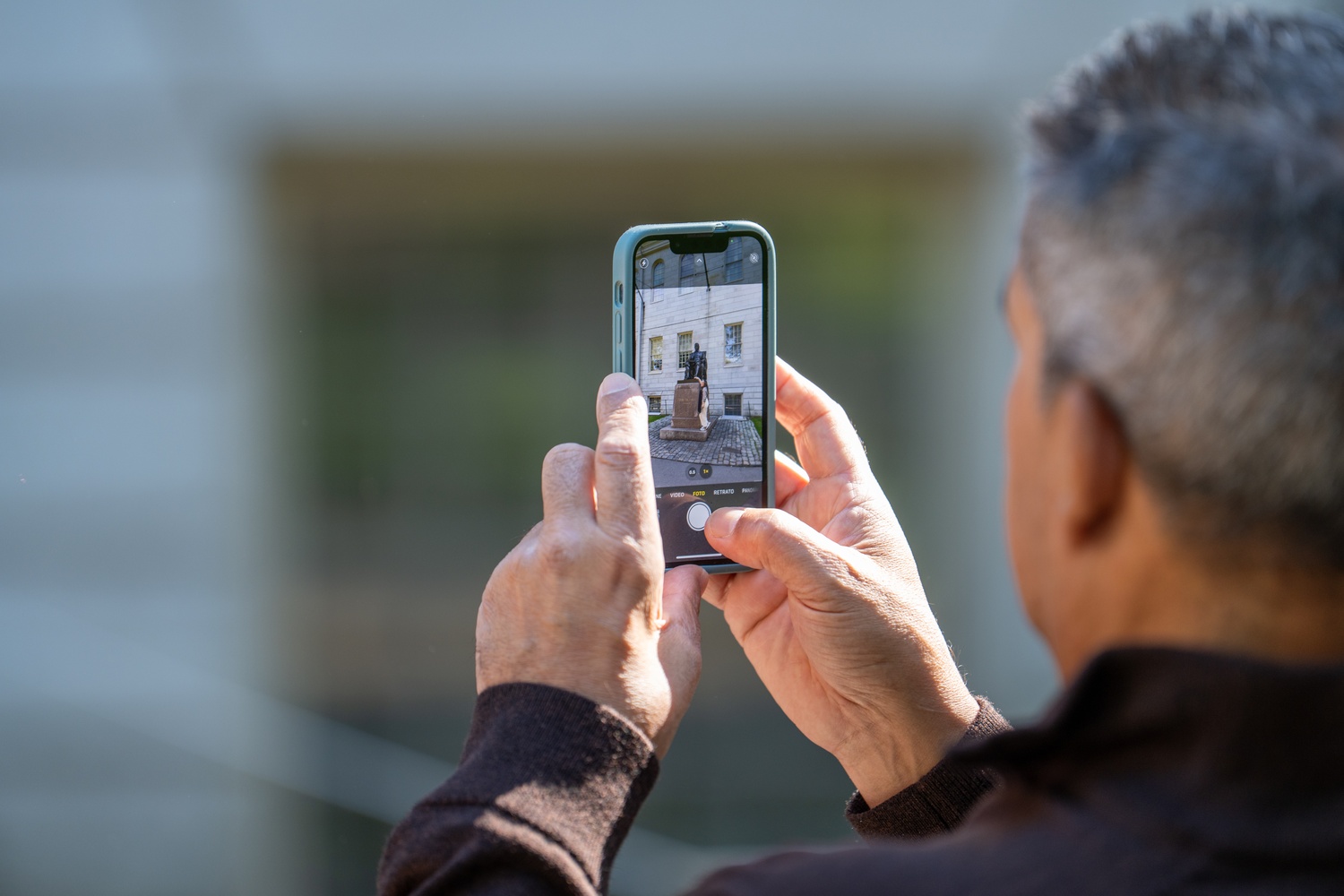
Among Tourists in the Yard
The faint smell of urine perfumes the air as a throng of tourists lines up to touch the gleaming foot of John Harvard one beautiful Sunday morning. Turn the corner at University Hall and the steps of Widener Library are teeming with students who just want to drink their $8 oatmilk-matcha-lattes and read their vintage copies of “Hamlet” without finding themselves in the background of an Instagram photoshoot (or do they?). Across the yard, Memorial Church echoes with the sounds of French, Spanish, and Mandarin as tour guides lead fifty people past the masochists cramming for their Stat 110 midterm.
Some students view the millions of tourists visiting Harvard each year as a manageable nuisance — an unexpected game of parkour on their way to class. First world problems, right? However, when we spoke with those very same tourists, we gained a deeper appreciation for our college experience.
Mini Quintana and Jessica P. Thomas were lounging on the steps of University Hall when they were disturbed by two FM reporters. When asked about her perception of Harvard, Thomas calls it “iconic,” citing the “massive old trees canvassing the campus.” Thomas had last visited Harvard twenty years prior, for the wedding of Quintana’s daughter at Memorial Church. Quintana, who has lived in Cambridge for eight years, has nothing but fond memories of Harvard, recalling the “peace” of walking through the Yard and becoming immersed in such a “loved” institution.
The admiration tourists seem to hold for Harvard extends beyond the beauty of campus. Quintana summarizes Harvard in a befitting way: a place “chock full of history and diversity.” Another tourist, Maria Maldonado, says Harvard was the “first stop” on her trip in Boston, as it was a “super institution” which she “grew up watching movies about.” It was important enough to Maldonado that she even brought her son with her to experience it too.
Almost all of the tourists we spoke to mentioned the prestige of Harvard University. Chien Hung Chen, a tour guide from Taiwan, said that Harvard is a “very famous college in the U.S., so we must come here.” Ana Leil, a tourist from Portugal, echoes similar sentiments, saying that she had “heard so much” about Harvard that she felt it was important to make a stop during her tour of the American East Coast.
Jinjian Qiu, a Canadian tourist, remarks that “as Asian parents, we always bring our kids here” to encourage academic ambition, as he gestured towards his twelve-year-old daughter.
Two tour coordinators for the Crimson Key Society, Andrea A. G. Trujillo ’27 and Lauren M. Teichholtz ’26, say Harvard’s storied history seems to be another highlight for tour groups. “The Harvard name can mean a lot of things” to different people, Trujillo says. Each tour, Teichholtz is reminded of that “crazy feeling” of going to Harvard, a place that people go “out of their way” to come visit. And at the end of each tour, Teichholtz and Trujillo direct their audience’s attention to one detail just beside the statue: instead of all three books facing up on the Harvard crest, the third is turned facing down. Trujillo explains this represents the importance of “putting the book down and getting to appreciate attending such a special institution.”
In contrast to this lovely maxim, Morola Ajuwon ’29 expresses a sentiment of annoyance that many students relate to: unintentionally photobombing an amateur photoshoot on their way to class. “It’s a bit inconvenient,” Juliana L. Yao ’29 says of the constant commotion at the John Harvard statue — which causes her to change her route through the Yard and avoid it altogether.
Following her Historical Tour of Harvard, Myriam Lee, a tourist from Houston, notices how busy campus felt. “I imagine the students have been all around the campus, and busy, and running from one building to another,” she says. She adds that “they look friendly,” surprising those of us who spend all day with Harvard students. Shiromani Nega, visiting from Los Angeles, also reflects on Harvard’s bustling atmosphere and is impressed with its diversity. Nega says she likes “the mix of locals, students, and tourists” and that “it seems like a very open campus.”
For some students, the constant flow of tourists prompts a quiet moment of reflection amid the chaos of exams, clubs, and fighting for laundry machines. Even Ajuwon, despite the occasional annoyance, emphasizes that “I’m privileged to be here, and there’s other people who don’t have that privilege, and so if they get to experience that for a day, so be it.” In fact, every student that we interviewed (and consequently disrupted from performatively reading on the steps of Widener) echoes the same sentiment. Indeed, the awe, the “honor,” which Maldonado feels on campus, appears to linger as a gentle reminder of the wonder that is at the heart of Harvard.
Conducting these interviews reminded us that Harvard is more than just a place of learning. While it is undeniably a place of renown, it is not a bubble of frantic energy, midterms, and performativity. We aren’t isolated from the rest of the world, and the thousands of tourists remind us of this. But the most essential takeaway from our time in the Yard comes in the form of a simple piece of advice from Quintana, which we believe will benefit all of Harvard: “Find a good husband.”


